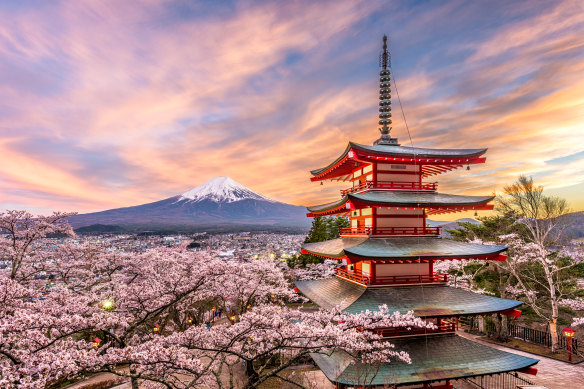As millions seek out prime locations to catch a glimpse of Japan’s famed cherry blossoms, or sakura, their enjoyment hinges on one of the most unusual forecasts in the world.
Each year, meteorologist Hiroki Ito predicts blooming dates for about a thousand sites across the island nation’s towns and cities. And he’s far from alone, in a crowded industry that has grown to cater for tourists and locals clamouring to get that perfect Instagram shot of the ephemeral pink petals.

Cherry blossoms are a key part of Japan’s tourism industry, which has been ravaged by the pandemic.Credit:iStock
While the practice of viewing the blossoms — known as hanami in Japan — is a centuries-old tradition, it’s also good for business. Some ¥616 billion ($7.1 billion) in economic activity will be generated in 2023, according to an estimate by Osaka’s Kansai University. This year in particular, it’s thrown a lifeline to the country’s struggling tourism sector, which was ravaged by the COVID-19 pandemic.
That’s adding to the pressure on Ito, who is employed by and makes predictions for Osaka-based Japan Meteorological Corp., one of the major private providers of cherry-blossom blooming data. Small and big businesses alike — from Starbucks, which rolls out sakura-themed lattes during spring, to tour operators and accommodation providers — depend on the season for highly profitable marketing campaigns and promotions, making the forecasts closely scrutinised.
“There is strong attention from the public, so if you make a prediction, it will be seen by many people,” said the 37-year-old, who collects temperature readings year round to fine-tune his computer models. “It will also lead to increased recognition of your company.”
Incorrect forecasts can be damaging, as national forecaster Japan Meteorological Agency found back in 2007, when it was forced to make a public apology after predictions missed the mark by nine days and “caused some trouble.“. It stopped publishing forecasts more than a decade ago due to the proliferation of businesses providing the service.
The viewing window at any given location is short, with peak bloom, or mankai, typically lasting around one week. Ito makes his initial forecasts for the year in January and then adjusts them regularly until the main event. At the beginning of 2023, he predicted blooms would open in Tokyo on March 22. But by the beginning of the month, due to unseasonably warm weather, his seventh forecast had shifted to March 15. He was just one day late.
In recent years, predictions have increasingly been complicated by the effects of climate change, with unseasonal temperatures throwing forecasters a curveball. The trees’ flower buds form as early as summer and lie dormant until the winter, which kick-starts the flowering process. Any unusual temperature variations can affect blooming times.
Stay connected with us on social media platform for instant update click here to join our Twitter, & Facebook
We are now on Telegram. Click here to join our channel (@TechiUpdate) and stay updated with the latest Technology headlines.
For all the latest Business News Click Here
For the latest news and updates, follow us on Google News.
